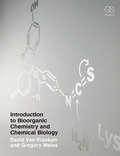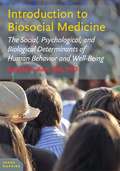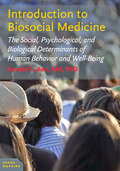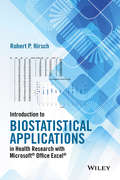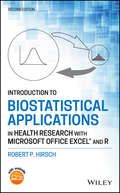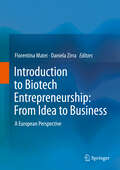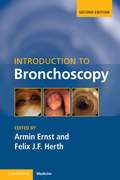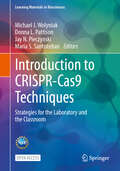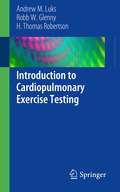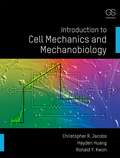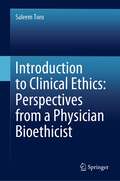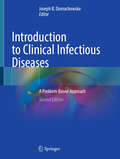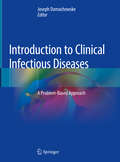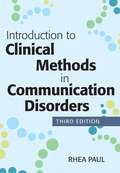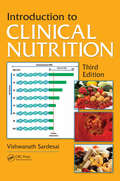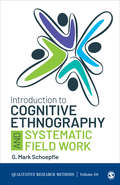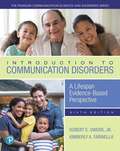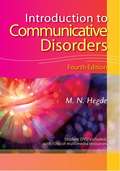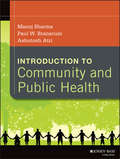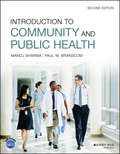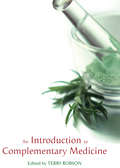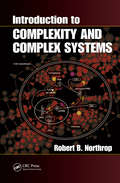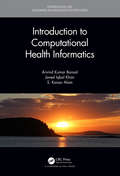- Table View
- List View
Introduction to Bioorganic Chemistry and Chemical Biology
by David Van Vranken Gregory A. WeissIntroduction to Bioorganic Chemistry and Chemical Biology is the first textbook to blend modern tools of organic chemistry with concepts of biology, physiology, and medicine. With a focus on human cell biology and a problems-driven approach, the text explains the combinatorial architecture of biooligomers (genes, DNA, RNA, proteins, glycans, lipids, and terpenes) as the molecular engine for life. Accentuated by rich illustrations andmechanistic arrow pushing, organic chemistry is used to illuminate the central dogma of molecular biology.Introduction to Bioorganic Chemistry and Chemical Biology is appropriate for advanced undergraduate and graduate students in chemistry and molecular biology, as well as those going into medicine and pharmaceutical science.Please note that Garland Science flashcards are no longer available for this text. However, the solutions can be obtained through our Support Material Hub link below, but should only be requested by instructors who have adopted the book on their course.
Introduction to Biosocial Medicine: The Social, Psychological, and Biological Determinants of Human Behavior and Well-Being
by Donald A. Barr<p>While 40 percent of premature deaths in the United States can be attributed to such dangerous behaviors as smoking, overeating, inactivity, and drug or alcohol use, medical education has generally failed to address how these behaviors are influenced by social forces. This new textbook from Dr. Donald A. Barr was designed in response to the growing recognition that physicians need to understand the biosocial sciences behind human behavior in order to be effective practitioners. Introduction to Biosocial Medicine explains the determinants of human behavior and the overwhelming impact of behavior on health. <p>Drawing on both recent and historical research, the book combines the study of the biology of humans with the social and psychological aspects of human behavior. Dr. Barr, a sociologist as well as physician, illustrates how the biology of neurons, the intricacies of the human mind, and the power of broad social forces all influence individual perceptions and responses. Addressing the enormous potential of interventions from medical and public health professionals to alter these patterns of human behavior over time, Introduction to Biosocial Medicine brings necessary depth and perspective to medical training and education.</p>
Introduction to Biosocial Medicine: The Social, Psychological, and Biological Determinants of Human Behavior and Well-Being
by Donald A. BarrUnderstanding human behavior is essential if medical students and doctors are to provide more effective health care.While 40 percent of premature deaths in the United States can be attributed to such dangerous behaviors as smoking, overeating, inactivity, and drug or alcohol use, medical education has generally failed to address how these behaviors are influenced by social forces. This new textbook from Dr. Donald A. Barr was designed in response to the growing recognition that physicians need to understand the biosocial sciences behind human behavior in order to be effective practitioners. Introduction to Biosocial Medicine explains the determinants of human behavior and the overwhelming impact of behavior on health. Drawing on both recent and historical research, the book combines the study of the biology of humans with the social and psychological aspects of human behavior. Dr. Barr, a sociologist as well as physician, illustrates how the biology of neurons, the intricacies of the human mind, and the power of broad social forces all influence individual perceptions and responses. Addressing the enormous potential of interventions from medical and public health professionals to alter these patterns of human behavior over time, Introduction to Biosocial Medicine brings necessary depth and perspective to medical training and education.
Introduction to Biostatistical Applications in Health Research with Microsoft Office Excel
by Robert P. HirschA practical and methodological approach to the statistical logic of biostatistics in the field of health research Focusing on a basic understanding of the methods and analyses in health research, Introduction to Biostatistical Applications in Health Research with Microsoft® Office Excel® provides statistical concepts for interpreting results using Excel. The book emphasizes the application of methods and presents the most common methodological procedures in health research, which includes multiple regression, ANOVA, ANCOVA, logistic regression, Cox regression, stratified analysis, life table analysis, and nonparametric parallels. The book is constructed around a flowchart that outlines the appropriate circumstances for selecting a method to analyze a specific set of data. Beginning with an introduction to the foundational methods of statistical logic before moving on to more complex methods, Introduction to Biostatistical Applications in Health Research with Microsoft® Office Excel® also includes: Detailed discussions of how knowledge and skills in health research have been integrated with biostatistical methods Numerous examples with clear explanations that use mostly real-world health research data in order to provide a better understanding of the practical applications Implements Excel graphic representations throughout to help readers evaluate and analyze individual results An appendix with basic information on how to use Excel A companion website with additional Excel files, data sets, and homework problems as well as an Instructor's Solutions Manual Introduction to Biostatistical Applications in Health Research with Microsoft® Office Excel® is an excellent textbook for upper-undergraduate and graduate-level courses in biostatistics and public health. In addition, the book is an appropriate reference for both health researchers and professionals.
Introduction to Biostatistical Applications in Health Research with Microsoft Office Excel and R
by Robert P. HirschThe second edition of Introduction to Biostatistical Applications in Health Research delivers a thorough examination of the basic techniques and most commonly used statistical methods in health research. Retaining much of what was popular with the well-received first edition, the thoroughly revised second edition includes a new chapter on testing assumptions and how to evaluate whether those assumptions are satisfied and what to do if they are not. The newest edition contains brand-new code examples for using the popular computer language R to perform the statistical analyses described in the chapters within. You’ll learn how to use Excel to generate datasets for R, which can then be used to conduct statistical calculations on your data. The book also includes a companion website with a new version of BAHR add-in programs for Excel. This new version contains new programs for nonparametric analyses, Student-Newman-Keuls tests, and stratified analyses. Readers will also benefit from coverage of topics like: Extensive discussions of basic and foundational concepts in statistical methods, including Bayes’ Theorem, populations, and samples A treatment of univariable analysis, covering topics like continuous dependent variables and ordinal dependent variables An examination of bivariable analysis, including regression analysis and correlation analysis An analysis of multivariate calculations in statistics and how testing assumptions, like assuming Gaussian distributions or equal variances, affect statistical outcomes Perfect for health researchers of all kinds, Introduction to Biostatistical Applications in Health Research also belongs on the bookshelves of anyone who wishes to better understand health research literature. Even those without a great deal of mathematical background will benefit greatly from this text.
Introduction to Biotech Entrepreneurship: A European Perspective
by Florentina Matei Daniela ZirraPrimarily intended for biotechnology graduates, this handbook provides an overview of the requirements, opportunities and drawbacks of Biotech Entrepreneurship, while also presenting valuable training materials tailored to the industrial and market reality in the European Biotech Business. Potential investors and business consultants will find essential information on the benefits and potential risks involved in supporting biotech businesses. Further, the book addresses a broad range of Biotechnology fields, e.g. food biotech, industrial biotech, bioinformatics, animal and human health. Readers will learn the essentials of creating innovations, founding a biotech start-up, business management strategies, and European funding sources. In addition, the book discusses topics such as intellectual property management and innovation transfer.The book offers a comparative analysis of different countries’ perspectives and reviews the status quo in Western and Eastern European regions, also in comparison with other leading biotech countries such as the USA and Canada. A long list of potentially profitable biotech start-up ideas and a collection of success stories involving European companies are also included.The book is based on the Erasmus+ Strategic Partnership project “Supporting biotechnology students oriented towards an entrepreneurial path” (www.supbioent.usamv.ro), which involved the collaboration of Life Sciences and Economics departments at higher education institutions throughout Western and Eastern Europe.
Introduction to Bronchoscopy
by Armin Ernst Herth Felix J. F.Bronchoscopic procedures are commonly performed for diagnosis of respiratory disorders and therapeutic airway treatment and management. A thorough understanding of procedural and technical fundamentals is critical for improving yield and safety, but they are not featured in procedural reviews for advanced endoscopists. In this book those critical cornerstones of performing bronchoscopy are discussed and explained in detail. Following the successful structure of the first edition, the fully updated content provides detailed reviews of procedural fundamentals including endobronchial ultrasound. Equipment components are described and maintenance is discussed. All chapters include advice on procedural quality improvement. Regulatory requirements, bronchoscopy procedure unit design and management principles are also addressed. This text will be beneficial to a wide range of practitioners including trainees and specialists in pulmonary and all critical care fields, surgeons, anaesthesiologists and respiratory therapists.
Introduction to CRISPR-Cas9 Techniques: Strategies for the Laboratory and the Classroom (Learning Materials in Biosciences)
by Michael J. Wolyniak Donna L. Pattison Jay N. Pieczynski Maria S. SantistebanThis open-access textbook provides an in-depth introduction into the CRISPR-cas9 technology and explores its use across the gamut of biological model systems. As the subject has risen from a significant new discovery to a mainstream molecular biology practice, it is essential that students of molecular biology understand the fundamentals behind CRISPR-Cas9 technology and how it may be employed efficiently and ethically in research. This volume, edited by experts in both, molecular biology and undergraduate education, will teach not only the fundamentals of using CRISPR-Cas9, but also how to successfully employ this technology in classroom settings. The book is written for undergraduates and advanced high school classes in the area of molecular biology, genetics, genomics and biological engineering and will provide a perfect tool for undergraduate lecturers to prepare their classes.
Introduction to Cancer Biology
by Robin HeskethThis concise overview of the fundamental concepts of cancer biology is ideal for those with little or no background in the field. A summary of global cancer patterns introduces students to the general principles of how cancers arise and the risk factors involved. By focusing on fundamental examples of the signalling pathways within cells, the functional effects of DNA damage are explained. Later chapters then build on this foundation to provide a comprehensive summary of the major signalling pathways that affect tumour development. Current therapeutic strategies are reviewed, along with a discussion of methods for tumour detection and biomarker identification. Finally, the impact of whole genome sequencing is discussed, bringing students up to date with key recent developments in the field. From basic principles to insights into cutting-edge research, this book will enable the reader to move into the cancer field with confidence.
Introduction to Cardiopulmonary Exercise Testing
by Robb W. Glenny H. Thomas Robertson Andrew M. LuksCardiopulmonary exercise testing is an important diagnostic test in pulmonary medicine and cardiology. Capable of providing significantly more information about an individual's exercise capacity than standard exercise treadmill or 6-minute walk tests, the test is used for a variety of purposes including evaluating patients with unexplained exercise limitation or dyspnea on exertion, monitoring disease progression or response to treatment, determining fitness to undergo various surgical procedures and monitoring the effects of training in highly fit athletes. Introduction to Cardiopulmonary Exercise Testing is a unique new text that is ideal for trainees. It is presented in a clear, concise and easy-to-follow manner and is capable of being read in a much shorter time than the available texts on this topic. Chapters describe the basic physiologic responses observed during sustained exercise and explain how to perform and interpret these studies. The utility of the resource is further enhanced by several sections of actual patient cases, which provide opportunities to begin developing test interpretation skills. Given the widespread use of cardiopulmonary exercise testing in clinical practice, trainees in pulmonary and critical care medicine, cardiology, sports medicine, exercise physiology, and occasionally internal medicine, will find Introduction to Cardiopulmonary Exercise Testing to be an essential and one of a kind reference.
Introduction to Cell Mechanics and Mechanobiology
by Christopher R. Jacobs Hayden Huang Ronald Y. KwonIntroduction to Cell Mechanics and Mechanobiology is designed for a one-semester course in the mechanics of the cell offered to advanced undergraduate and graduate students in biomedical engineering, bioengineering, and mechanical engineering. It teaches a quantitative understanding of the way cells detect, modify, and respond to the physical prope
Introduction to Clinical Ethics: Perspectives from a Physician Bioethicist
by Saleem ToroThis textbook offers an introduction to the field of bioethics, specifically from a practicing physician standpoint. It engages a wide range of recent scholarship and emerging research covering many crucial topics in clinical ethics. While there has been increasing attention to the role of bioethics in medicine, the gap between theory and practice still exists, and it continues to impede the dialogue between health care professionals from one side and bioethicists and philosophers of medicine from the other side. This book builds bridges and open channels of connection between different parties in these conversations. It does so from a physician’s practical perspective, engaging recent scholarship and emerging research, to shed light on pivotal ethical dilemmas in contemporary clinical practice.
Introduction to Clinical Infectious Diseases: A Problem-Based Approach
by Joseph B. DomachowskeThe field of infectious diseases drifts and shifts as new pathogens emerge or re-emerge, new treatment modalities become available, and new prevention strategies are implemented. Students of medicine and the clinically experienced teachers who help to steer their education will benefit from Clinical Infectious Diseases: A Problem-Based Approach because each chapter first defines a clinical diagnosis and moves to descriptions of common and/or classic causes of the problem while including tables, lists and descriptions of the rare and unusual etiologies we all find so fascinating. General management approaches are included to help build foundations of clinical care of infections including, but not limited to the administration of antibiotics. Reminders of classic complications seen with specific infections and/or their treatment are used to emphasize the importance of ongoing vigilance even after a specific microbiologic diagnosis has been identified. Common causes of each problem are emphasized. Unusual and rare causes are mentioned briefly with clinical clues about when to consider them. Case descriptions are used to support, facilitate, and refine the learner’s deductive clinical reasoning skills. The book is written for a broad audience of medical trainees by a diverse group of medical experts, then edited by an infectious disease physician-scientist-educator to maintain a primary focus on the infection aspects of each problem. Basic content is reviewed first, then layered with advancing complexity. Call-out boxes are used to emphasize key concepts while figures and tables provide insights into more complex, rare but important and/or classic features of infection. As such, the book will appeal to a broad range of students and trainees from those just entering the health care field to those who have already reached subspecialty training.
Introduction to Clinical Infectious Diseases: A Problem-based Approach
by Joseph DomachowskeInfectious diseases as a specialty suffers from many unique challenges stemming from lower salaries compared to other medical specialties and difficulty keeping the younger demographic within the field. With emerging infections, new diagnostic and research tools, and changing migration patterns, these problems are amplified; infectious disease specialists are in higher demand than ever with fewer and fewer specialists available to support patients and colleagues outside of the field. To meet these increasing challenges, it is vital for the workforce of the future to have the best training possible. This book aims to provide this support. <P><P> As trainees, all physicians face clinical infectious disease scenarios on a daily basis. They receive basic training in common infections, giving them the tools needed for initial diagnostic studies and empiric treatment. This approach, however, still leaves them struggling with nuances of treating common infections, infections that masquerade as other diseases, rare infection, advanced diagnostics, complicating medical conditions, and a wide range of medical complexities. Important clinical microbiology details and host susceptibility risks will be highlighted when discussing uncommon infections. <P><P> Each chapter begins by defining a distinct clinical infectious disease problem and the most common cause(s). The next section of each chapter identifies the key questions to consider, including other possible pathogens, medical history, alternate microbiologic diagnoses, instances of unexpected result. This book is the only academic text designed specifically to meet this challenge by targeting learners at all levels. To do this, the text incorporate 30-40 common clinical infectious disease scenarios in both adult and pediatric hosts. It includes easy-to-access “tips and tricks” for when to look further or consider possibilities that are unusual that is useful for someone who is new to the information or has limited experience within infectious diseases. The text heavily features teaching and learning tools, including call out boxes that prioritizes infectious etiologies, host risk factors, important microbiologic clues, and important clinical history clues. The text also includes review questions and quiz-like challenges to reinforce the concepts. <P><P> Written by experts in the field Clinical Infectious Diseases is the most cutting-edge academic resource for all medical students, fellows, residents, and trainees, including infectious disease specialists in both adult and pediatric care, internal medicine specialists, and hospitalists.
Introduction to Clinical Methods In Communication Disorders Third Edition
by Rhea PaulThe bestselling core textbook on communication disorders is better than ever with this new third edition, thoroughly revised and based on updated ASHA standards. Covering a broad range of disorders and developmental levels, this text gives future professionals up-to-date guidance on evidence-based practice from more than 20 academics and working clinicians. Preservice SLPs and audiologists will get a comprehensive guide to contemporary clinical practice--one they will use for the rest of their careers to provide the best possible services for people with communication disorders. An essential text for all students in clinical methods courses and a reliable reference for practicing professionals!
Introduction to Clinical Nutrition
by Vishwanath SardesaiDietary factors have been implicated in at least four of the ten leading causes of death in the U.S. (heart disease, cancer, diabetes, and stroke). Nevertheless, physicians frequently receive inadequate training in nutrition to properly counsel their patients. Introduction to Clinical Nutrition, Third Edition discusses the physiologic and metabolic
Introduction to Cognitive Ethnography and Systematic Field Work (Qualitative Research Methods)
by G. Mark SchoepfleIntroduction to Cognitive Ethnography and Systematic Field Work by G. Mark Schoepfle provides a guide to the fundamentals of cognitive ethnography for qualitative research. A focus of this technique is collecting data from flexible but rigorous interviews. These interviews are flexible because they are designed to be structured around the semantic knowledge being elicited from the speaker, not around some pre-conceived design that is based on the researcher’s background, and they are rigorous because the basic linguistic and semantic structures are shared among all cultures. Written by one of the founders of this technique, this text provides a wealth of concentrated knowledge developed over years to best suit this collaborative and participant-centric research process. Eight chapters show how intertwined data collection and analysis are in this method. The first chapter offers a brief history and overview of the cognitive ethnography. Chapter 2 covers planning a research project, from developing a research question to ethics and IRB requirements. The next two chapters cover interview background, techniques, and structures. Chapter 5 addresses analysis while Chapter 6 covers transcription and translation. Chapter 7 covers observation, while a final chapter address writing a report for both consultants and outside audiences.
Introduction to Cognitive Ethnography and Systematic Field Work (Qualitative Research Methods)
by G. Mark SchoepfleIntroduction to Cognitive Ethnography and Systematic Field Work by G. Mark Schoepfle provides a guide to the fundamentals of cognitive ethnography for qualitative research. A focus of this technique is collecting data from flexible but rigorous interviews. These interviews are flexible because they are designed to be structured around the semantic knowledge being elicited from the speaker, not around some pre-conceived design that is based on the researcher’s background, and they are rigorous because the basic linguistic and semantic structures are shared among all cultures. Written by one of the founders of this technique, this text provides a wealth of concentrated knowledge developed over years to best suit this collaborative and participant-centric research process. Eight chapters show how intertwined data collection and analysis are in this method. The first chapter offers a brief history and overview of the cognitive ethnography. Chapter 2 covers planning a research project, from developing a research question to ethics and IRB requirements. The next two chapters cover interview background, techniques, and structures. Chapter 5 addresses analysis while Chapter 6 covers transcription and translation. Chapter 7 covers observation, while a final chapter address writing a report for both consultants and outside audiences.
Introduction to Communication Disorders: A Lifespan Evidence-Based Perspective
by Robert E. Owens Dale Evan Metz Kimberly A. FarinellaA clear, comprehensive introduction to communication sciences and disorders Introduction to Communication Disorders: A Lifespan Evidence-Based Perspective presents recent advances in the assessment and treatment of communication disorders in a highly readable manner. Each chapter is concise, yet comprehensive-striking a just right balance of information appropriate for introductory-level students. Readers gain a basic foundation in the areas of anatomy and physiology of speech and hearing, and an overview of the various disorders that affect voice, fluency, articulation, language, cognition, swallowing, and hearing across the lifespan. Updated case studies, evidence-based practice summary boxes, and new medically based photographs help students bridge the gap between theory and clinical application.
Introduction to Communicative Disorders (4th edition)
by M. N. HegdeIn this update of the 2001, 1995, and 1991 editions, Hegde (communication sciences and disorders, California State U. , Fresno) introduces the rapidly growing science of communication and profession of communicative disorders. Coverage includes a new chapter on literacy skills in children and the role of the speech-language pathologist in literacy intervention; profiles of speech-language pathologists and audiologists; and expanded material on audiology, audiology rehabilitation, and disorders of swallowing. The text includes study questions; information on professional education, organizations, and standards; a glossary.
Introduction to Community and Public Health
by Manoj Sharma Paul W. Branscum Ashutosh AtriLearn the basics of the five core areas of community and public health Introduction to Community and Public Health covers the basics in each area of community and public health as identified by the Association of Schools of Public Health. In a student-friendly approach, authors Manoj Sharma, Paul W. Branscum, and Ashutosh Atri discuss epidemiology, biostatistics, social and behavioral sciences, environmental health, and healthy policy and management. Written to serve both graduate and undergraduate public health students, as well as to help prepare for the Certified in Public Health (CPH) exam, Certified Health Education Specialist (CHES) exam and Master certified in Health Education Specialist (MCHES) exam, the book covers each of these five core disciplines, plus other important topics such as: Population dynamics and control Air, water, and noise pollution, and other environmental issues Program planning, budgeting, management, and evaluation Systems thinking and leadership in community and public health Students will gain insight into the descriptive, inferential, and analytical aspects of community and public health, as well as models, methods, and theories in health education and health promotion. Introduction to Community and Public Health provides the foundation necessary to build the skills of tomorrow's community and public health leaders.
Introduction to Community and Public Health
by Manoj Sharma Paul W. BranscumLearn the basics of the five core areas of community and public health Introduction to Community and Public Health, 2nd Edition covers the basics in each area of community and public health as identified by the Association of Schools of Public Health. With a student-friendly approach, the authors discuss epidemiology, biostatistics, social and behavioral sciences, environmental health, and healthy policy and management. The book is written to serve both graduate and undergraduate public health students, as well as to help prepare for the Certified in Public Health (CPH) exam, Certified Health Education Specialist (CHES) exam and Master certified in Health Education Specialist (MCHES) exam, the book covers each of these five core disciplines, plus other important topics.
Introduction to Complementary Medicine
by Terry Robson* What is complementary medicine?* What evidence is there to support its use?* What can orthodox medicine learn from holistic practices? Providing a sound introduction to the range of treatments and philosophies usually termed 'complementary and alternative medicine', this book offers a systematic explanation of the philosophies and practices that underpin contemporary complementary medicine.Introduction to Complementary Medicine examines the rise in popularity of complementary medicine and discusses the challenges of developing a more integrated system of health care. Drawing on recent research, this book explores the development, application, evidence, contraindications and appropriateness of a wide range of traditional systems of medicine and healing modalities, including Herbal Medicine, Massage, Osteopathy, Traditional Chinese Medicine, Aromatherapy, Chiropractic, Ayurveda, Yoga and Meditation.Written by leading academics, researchers and experienced practitioners, Introduction to Complementary Medicine is designed to be used as a reference for students and practitioners in a range of health professions.With a foreword by Dr Joseph Pizzorno ND
Introduction to Complexity and Complex Systems
by Robert B. NorthropThe boundaries between simple and complicated, and complicated and complex system designations are fuzzy and debatable, even using quantitative measures of complexity. However, if you are a biomedical engineer, a biologist, physiologist, economist, politician, stock market speculator, or politician, you have encountered complex systems. Furthermore
Introduction to Computational Health Informatics (Chapman & Hall/CRC Data Mining and Knowledge Discovery Series)
by Arvind Kumar Bansal Javed Iqbal Khan S. Kaisar AlamThis class-tested textbook is designed for a semester-long graduate or senior undergraduate course on Computational Health Informatics. The focus of the book is on computational techniques that are widely used in health data analysis and health informatics and it integrates computer science and clinical perspectives. This book prepares computer science students for careers in computational health informatics and medical data analysis. Features Integrates computer science and clinical perspectives Describes various statistical and artificial intelligence techniques, including machine learning techniques such as clustering of temporal data, regression analysis, neural networks, HMM, decision trees, SVM, and data mining, all of which are techniques used widely used in health-data analysis Describes computational techniques such as multidimensional and multimedia data representation and retrieval, ontology, patient-data deidentification, temporal data analysis, heterogeneous databases, medical image analysis and transmission, biosignal analysis, pervasive healthcare, automated text-analysis, health-vocabulary knowledgebases and medical information-exchange Includes bioinformatics and pharmacokinetics techniques and their applications to vaccine and drug development
